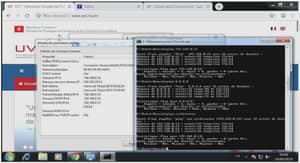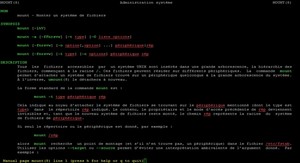Sommaire: Networking the linux system administrators guide
Dedication
Source and pre-formatted versions available
1. Introduction
The Linux Documentation Project
2. Overview of a Linux System
V arious parts of an operating system
Important parts of the kernel
Major services in a UNIX system
init
Logins from terminals
Syslog
Periodic command execution: cron and at
Graphical user interface
Networking
Network logins
Network file systems
Mail
Printing
The filesystem layout
3. Overview of the Directory T ree
Background
The root filesystem
The /etc directory
The /dev directory
The /usr filesystem
The /var filesystem
The /proc filesystem
4. Using Disks and Other Storage Media
Two kinds of devices
Hard disks
Floppies
CD-ROM’s
T apes
Formatting
Partitions
The MBR, boot sectors and partition table
Extended and logical partitions
Partition types
Partitioning a hard disk
Device files and partitions
Filesystems
What are filesystems?
Filesystems galore
Which filesystem should be used?.
Creating a filesystem
Mounting and unmounting
Checking filesystem integrity with fsck
Checking for disk errors with badblocks
Fighting fragmentation
Other tools for all filesystems
Other tools for the ext2 filesystem.
Disks without filesystems
Allocating disk space
Partitioning schemes
Space requirements
Examples of hard disk allocation
Adding more disk space for Linux
Tips for saving disk space
5. Memory Management
What is virtual memory?
Creating a swap space
Using a swap space
Sharing swap spaces with other operating systems.
Allocating swap space
The buffer cache
6. Boots And Shutdowns
An overview of boots and shutdowns
The boot process in closer look
More about shutdowns
Rebooting
Single user mode
Emergency boot floppies
7. init
init comes first
Configuring init to start getty: the /etc/inittab file
Run levels
Special configuration in /etc/inittab
Booting in single user mode
8. Logging In And Out
Logins via terminals
Logins via the network
What login does
X and xdm
Access control
Shell startup
9. Managing user accounts
What’s an account?
Creating a user
/etc/passwd and other informative files
Picking numeric user and group ids
Initial environment: /etc/skel
Creating a user by hand
Changing user properties
Removing a user
Disabling a user temporarily
10. Backups
On the importance of being backed up
Selecting the backup medium
Selecting the backup tool
Simple backups
Making backups with tar
Restoring files with tar
Multilevel backups
What to back up
Compressed backups
11. Keeping Time
Time zones
The hardware and software clocks
Showing and setting time
When the clock is wrong
Glossary (DRAFT)
Extrait du cours networking the linux system administrators guide
Chapter 1. Introduction
“In the beginning, the file was without form, and void; and emptiness was upon the face of the bits. And the Fingers of the Author moved upon the face of the keyboard. And the Author said, Let there be words, and there were words.”
This manual, the Linux System Administrators’ Guide, describes the system administration aspects of using Linux. It is intended for people who know next to nothing about system administration (as in what is it?”), but who have already mastered at least the basics of normal usage. This manual also doesn’t tell you how to install Linux; that is described in the Installation and Getting Started document.
See below for more information about Linux manuals.
System administration is all the things that one has to do to keep a computer system in a useable shape. It includes things like backing up files (and restoring them if necessary), installing new programs, creating accounts for users (and deleting them when no longer needed), making certain that the filesystem is not corrupted, and so on. If a computer were, say , a house, system administration would be called maintenance, and would include cleaning, fixing broken windows, and other such things. System administration is not called maintenance, because that would be too simple.
The Linux Documentation Project
The Linux Documentation Project, or LDP , is a loose team of writers, proofreaders, and editors who are working together to provide complete documentation for the Linux operating system. The overall coordinator of the project is Greg Hankins.
This manual is one in a set of several being distributed by the LDP , including a Linux Users’ Guide,System Administrators’ Guide, Network Administrators’ Guide, and Kernel Hackers’ Guide. These manuals are all available in source format, .dvi format, and postscript output by anonymous FTP from sunsite.unc.edu, in the directory /pub/Linux/docs/LDP.
We encourage anyone with a penchant for writing or editing to join us in improving Linux documentation. If you have Internet e-mail access, you can contact Greg Hankins at <gregh@sunsite.unc.edu>.
Notes
1. There are some people who do call it that, but that’ s just because they have never read this manual,poor things.
Chapter 2. Overview of a Linux System
“God looked over everything he had made, and saw that it was very good. ” (Genesis 1:31) This chapter gives an overview of a Linux system. First, the major services provided by the operating system are described. Then, the programs that implement these services are described with a considerable lack of detail. The purpose of this chapter is to give an understanding of the system as a whole, so that each part is described in detail elsewhere.
Various parts of an operating system
A UNIX operating system consists of a kernel and some system programs. There are also some application programs for doing work. The kernel is the heart of the operating system.It keeps track of files on the disk, starts programs and runs them concurrently, assigns memory and other resources to various processes, receives packets from and sends packets to the network, and so on. The kernel does very little by itself, but it provides tools with which all services can be built. It also prevents anyone from accessing the hardware directly, forcing everyone to use the tools it provides. This way the kernel provides some protection for users from each other. The tools provided by the kernel are used via system calls; see manual page section 2 for more information on these.
The system programs use the tools provided by the kernel to implement the various services required from an operating system. System programs, and all other programs, run ‘on top of the kernel’, in what is called the user mode. The difference between system and application programs is one of intent: applications are intended for getting useful things done (or for playing, if it happens to be a game),whereas system programs are needed to get the system working. A word processor is an application; telnet is a system program. The difference is often somewhat blurry, however, and is important only to compulsive categorizers.
……..
Cours networking the linux system administrators guide (417 KO) (Cours PDF)



